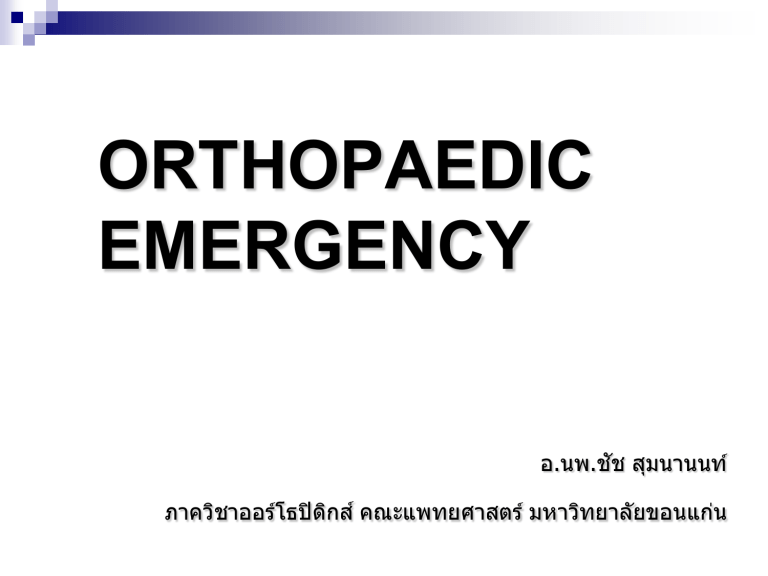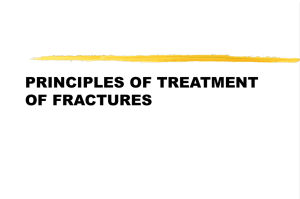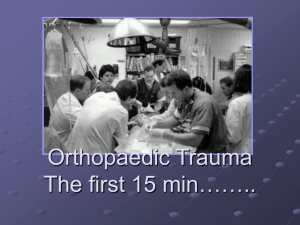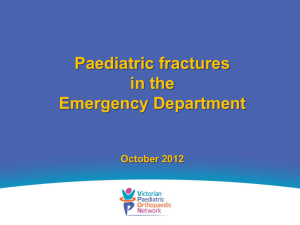orthopaedic emergency

ORTHOPAEDIC
EMERGENCY
อ.นพ.ชัช สุมนานนท์
ภาควิชาออร์โธปิดิกส์ คณะแพทยศาสตร์ มหาวิทยาลัยขอนแก่น
Objective
สามารถล าดับความส าคัญของภาวะฉุกเฉินในผู ้ป่วยที่มี
ภาวะบาดเจ็บทางออร์โธปิดิกส์ และภาวะบาดเจ็บร่วม
อื่นได ้
สามารถบอกแนวทางการรักษาเบื้องต ้น และสามารถ
ปฏิบัติตามแนวทางปฏิบัติได ้อย่างเหมาะสม
สามารถอธิบายลักษณะของการบาดเจ็บที่พบบ่อย และ
ที่ส าคัญของผู ้ป่วยที่มีภาวะบาดเจ็บเฉพาะทางออร์โธปิ
ดิกส์
Background
Musculoskeletal injury: very common in major trauma
Incidence of significant orthopaedic injury in severe injured patient is 78%
Permanent disability after major trauma from musculoskeletal or CNS injury
Background
Orthopaedic injury occurs as part of:
Multiple orthopaedic injuries only
Multisystem trauma, with multiple orthopaedic injuries
Multisystem injury with minor (not lifethreatening) orthopaedic injury
Resuscitation
Orthopaedic haemorrhage control ( “ C ” part of primary survey)
Secondary survey
Injury recognition: high energy limb injuries
Timing of surgery
Orthopaedic intervention
Orthopaedic surgical priorities
Ischaemia correction
Wound care
Long bone stabilization
Other fractures
Reaming for femoral shaft fracture – reaming and pulmonary failure
Principle of external fixation
Compartment syndrome
Limb salvage versus amputation
Orthopaedic haemorrhage control
Address and control sources of catastrophic haemorrhage
Direct pressure controls (most peripheral bleeding)
Broken bones bleed
Femur 1000 cm3
Tibia 750 cm3
Plevic fracture 2000 cm3
Orthopaedic haemorrhage control
Splinting reduces blood loss (pre-hospital)
Continued hypotension is unlikely in isolated long bone fracture
Look elsewhere
Pelvic bleeding kills
Unstable pelvic fractures need to be stabilized quickly
20-25% of all major trauma deaths have a pelvic fracture
Secondary survey
Orthopaedic injuries usually identified during the secondary survey
History: mechanism of injury
Detailed history
Patterns of orthopaedic injury exists
Falls from height: calcaneal fractures, tibial fractures and spinal fractures
Examination
Major long bone fractures usually obvious
Limb deformed/short
Up to 10% of lesser fracture may be missed (use
Tertiary Survey)
All fractures are important to the patient
Secondary survey
Assess major joints for active and passive ROM and stability
Careful palpate long bones for
pain, crepitus, and abnormal movement
Look carefully for open fractures
Orthopaedic emergency ( must not be missed )
May only be a puncture wound
Bleed – local pressure
Cover loosely by appropriate sterile dressing
OR (debridement) within 6 h
Broad spectrum antibiotic
Tetanus toxoid/immunoglubulin
Secondary survey
Don’t forget to logroll : assess for all spine
Splint the injury site
Reduces pain and further damage to local structure
Reduces blood loss
Splint the joint above and below the fracture site
Check distal neurological status and circulation before and after applying splint
Femoral fractures are placed in a traction splint
(Thomas), other limb fractures use plaster of Paris
Secondary survey
Radiological imaging
Low threshold for obtaining radiographs of area of concern
Radiographs need to be repeated (if poor quality) Do not forgotten about it
Appropriate timing of assessment
Specialized imaging
CT, MRI
Injury recognition:
high energy limb injuries
The surgical fracture and soft tissue management is complex – the prognosis and outcome is corresponding worse
History
Any road traffic accident
Fall from a height
General or localized crushing
Missile wounds
Contamination
History of entrapment in any period
History of limb ischemia
Injury recognition:
high energy limb injuries
Examination
Large or multiple wounds
Imprints or contamination
Crush or burst wounds
Skin degloving
Ipsilateral fracture
Evidence of associated compartment syndrome, vascular injuries, and nerve injuries
Injury recognition:
high energy limb injuries
Plain radiography
Segmental fracture
Highly comminutes fractures
Wide displacement of bone fragments
Evidence of air in the soft tissues
Timing of surgery
An injury results in an inflammatory reaction which is promote healing and repair, but if prolonged or exaggerated leading to systemic inflammatory response syndrome , acute respiratory distress syndrome (ARDS)
Aim: to control inflammatory response and restore normal physiology and homeostasis
ASAP
Timing of surgery
Reducing the overall inflammatory response
Remove necrotic/devitalized tissue by debridement/fasciotomy
Reduce blood loss and pain by splinting/stabilizing fractures
Reduce ischemia by joint relocation/fasciotomy/stabilizing fracture
Inflammatory response increases in: excessive surgery – blood loss/hypothermia
Orthopaedic intervention
Life-saving condition should taken first
Stable/suitable condition limb salvage procedures
Communication and coordination with other specialty
The initial goal is patient survival
(life limb function)
Orthopaedic intervention
Physiologic assessment at each stage
Danger signs
Hypoxia
Hypothermia
Abnormal clotting
Acidosis
Increase intracranial pressure
Orthopaedic surgical priorities
Ischaemia correction
Wound care
Long bone stabilization
Other fractures
Reaming for femoral shaft fracture – reaming and pulmonary failure
Principle of external fixation
Compartment syndrome
Limb salvage versus amputation
Ischaemia correction
Identify and correct the source of haemorrhagic shock
Reduce dislocated joints
Splint limbs in anatomical position
Stabilized fractures if associated vascular repair is required
Fasciotomy for compartment syndrome
Avoid hypothermia
Wound care
Open fracture need to be debrided and stabilized within
6 h
Tourniquet (not necessary)
Remove contaminants
Excise necrotic or devitalized tissue and skin margins
Copious irrigation
Minimum 6 liter saline
Pressurized and pulsatile lavage
Viability of muscle: “ 4 C ” – colour, contractility, consistency, capacity to bleed
After debridement “Do not close wound primarily”
Wound care
Close joint capsule
Cover bone end by viable soft tissue
Re-inspect the wound within 48 h
Definite wound closure should be within 5 days of injury
Antibiotic until definite wound closure is controversial
Wound care
Fracture stabilization after wound care
Choice depends on:
Fracture configuratrion
Fracture grade
Extent of soft tissue damage/contamination
Surgical experience
Gustilo and Anderson open fracture classification
Long bone stabilization
Femoral shaft fractures and pelvic stabilization should within 24 h
Reduce overall patient morbidity and mortality
Excellent pain control
Avoids traction and associated difficulty sitting and moving
Femoral shaft fractures are the next priority after pelvic stabilization
Closed IM nailing – treatment of choice
Temporary EF
Other fractures
Femoral neck fracture and talar neck fracture are the next priority ( risk of avascular necrosis )
Followed by:
Metaphyseal distal femoral fracture
Proximal and distal metaphyseal tibial fractures
Ankle fractures
Foot fractures
Wrist/elbow fractures
Other fractures
Factors
Patient’s general condition
Requirement for specialized imaging
Soft tissue swelling (foot and ankle fractures may be delay for 2 weeks)
Ipsilateral limb (upper and lower extremities)
Surgical and nursing expertise
Implant avialability
Fatigue of theatre staff
Reaming for femoral shaft fracture
– reaming and pulmonary failure
Reamed femoral intramedullary nail should be avoid in blunt chest trauma patient (ARDS)
Principle of external fixation
Suitable for many different injury patterns
Provisional stabilization
Quick and easy
Bloodless
Easily adjustable
Bridged fracture (complex articular fracture)
Alternative to IM nailing
Convert to IM nail within 2 weeks
Compartment syndrome
Results in fibrosis and nerve damage
Most common: lower leg, forearm, foot and in patient with major trauma
Easy to miss if: patient being resuscitated, paralysed or intoxicated
Signs:
Pain-more than expected
Pain-unrelieved by immobilization
Never assume pain is from the bone
Pain on passive stretching of the affected compartment
A tense, swollen limb
Pulselessness, pallor, paresthesia and paralysis are late signs after damage has occured
Compartment syndrome
Normal compartment pressure is 0 mmHg
Isolated compartment pressure > 40 mmHg
Differential pressure (DBP) < 30 mmHg
Treatment
Fasciotomy
Release all dressings and splints down to the skin
Compartment syndrome can occur in open fracture
Limb salvage versus amputation
Difficult to decision
Need to discuss options with patient
Photographic evidence useful
MESS score: for decision making but not absolute
Factors involved decision making:
Extent of bony injury
Nerve supply (esp. posterior tibial nerve)
Crush injuries
Physiologic reserve
Smoking
Economic, psychological and social factors
Mass casualty situation
Common Musculoskeletal
Injuries
Multiple trauma: head, thoraco-abdominal injuries, long bone fracture and open joint injury
Crushed limb / blast injury / high fall
Traumatic amputation of limb or part of limb
Fx pelvis, severe, unstable with bleeding
Fx-dislocation long bone with vascular complication
Open (compound) Fx / joint injury
Gunfire / shotgun / high velocity missile injury
Common Musculoskeletal
Injuries
Fx-dislocation / spinal cord / brachial plexus injury
Fx-dislocation of major bone and joint
Compartment syndrome / ischemic limb
Ligamentous injury (rupture) of knee / ankle
Ruptured muscle / tendon
Bone and joint infection, hematogenous
Acute bursitis / tendinitis
Serious Causes of Death in
Orthopaedic Emergency
1.
2.
3.
High (upper) cervical spine injury
Severe fracture of pelvis with unstable and massive bleeding
Multiple crushed limb and trunk injury
Estimated Blood Loss from
Fracture
Pelvis
Femur
100-4,000 cc
400-2,700 cc
Tibia 250-1,800 cc
Humerus 200 – 800 cc
Assessment
Glasgow coma scale (GCS)
Musculoskeletal abbreviated injury score
(AIS) ISS
Revised trauma score
Trauma injury severity score (TRISS)
Glasgow Coma Scale (GCS)
Parameter
Eye opening
Spontaneous
To voice
To pain
None
Verbal response
Oriented
Confused
Inappropriate words
Incomprehensible sounds
None
Motor response
Obeys command
Localized pain
Withdraws to pain
Flexible to pain
Extension to pain
None
5
4
3
2
1
6
5
4
3
2
1
Score
4
3
2
1
Musculoskeletal Abbreviated Injury Score (AIS)
Injury Score
Contusions / sprains
Interphalangeal dislocation
Digital fracture
Hip dislocation
Closed humerus fracture
Clavicle fracture
Open humeral fracture
Crushed elbow or shoulder
Femoral fracture
Open tibial fracture
Above knee amputation
Severe pelvic fracture with blood loss
< 20% by volume
Severe pelvic fracture with blood loss
> 20% by volume
Unsurvivable
3
3
3
3
4
4
2
2
2
1
1
1
5
6
Revised Trauma Score (RTS)
Result
1-49
0
GCS
13-15
9-12
6-8
4-5
3
Respiratory rate (breaths/min)
10-29
>29
6-9
1-5
0
Systolic blood pressure (mm/Hg)
>89
76-89
50-75
Score
4
2
1
0
4
3
2
1
0
4
3
2
1
0
TRISS score to predict the probability of survival
Resuscitation
Resuscitation / treatment protocol based on ATLS guidelines
Resuscitation/Treatment Protocol Based on ATLS Guidelines
•
•
•
•
•
1. Primary survey and resuscitation (patient stabilization)
A Airway and cervical spine
B Breathing and oxygenation
C Circulation and hemorrhage
D Dysfunction of the CNS
E Exposure and environmental
2. Consider transfer to more appropriate hospital if indicated
•
•
•
•
•
3. Secondary survey
A Allergies
M Medicines
P Previous medical history/pregnancy
L Last meal
E Events leading to trauma
4. Definitive care
Early total care
Damage control surgery
5. Tertiary survey
Missed injuries
Steps
1. The important initial steps are to check that the airway is clear and maintained .
2. Breathing and oxygenation are maintained by examining for and treating a blocked airway, pneumothorax, tension pneumothorax, hemothorax, flail chest, or pericardial tamponade
Steps
3. Control hemorrhage and maintain circulation bilateral femoral fractures and pelvic fracture
Associated with significant occult blood loss
4. Fluid resuscitation (2 large-bore venous cannulas)
5. Immediate cross match
Steps
6. A thorough examination of the abdomen , pelvis, and limb looking for signs of abdominal and pelvic bleeding, pelvic instability, and hemorrhage and limb damage, particularly open fractures
Steps
7. Complete CNS examination patient’s responsiveness and GCS including neurological examination of the limb
8. Radiographical examination of the chest and pelvis (head, neck and spine if clinically required)
Steps
9. Adequate stabilization
10. Secondary survey and appropriate investigation
11. Management plan for definitive treatment life-threatening injuries should be treated first
12. Tertiary survey within 24 hours
9Rs
1.
Recognition
2
. Recussitation if required
3
. Respective system evaluation
4
. Respective system treatment
5
. Retention (retainment) I : temporary splinting, wound coverage, etc.
6
. Reduction
7
. Retention (retainment) II : definitive immobilization
8
. Rehabilitation
9
. Reconstruction
Resuscitation/Treatment Protocol Based on ATLS
Guidelines
1. Primary survey and resuscitation (patient stabilization)
A Airway and cervical spine
B Breathing and oxygenation
C Circulation and hemorrhage
D Dysfunction of the CNS
E Exposure and environmental
2. Consider transfer to more appropriate hospital if indicated
3. Secondary survey
A Allergies
M Medicines
P Previous medical history/pregnancy
L Last meal
E Events leading to trauma
4. Definitive care (Fracture treatment)
Early total care
Damage control surgery
5. Tertiary survey
Missed injuries
Early Total Care
Early femoral fracture fixation was associated with decreased pulmonary complications and reduced hospital stay
Long bones are more benefited
Damage Control Surgery
Early reamed femoral nailing or external fixation followed by secondary nailing
The second one is associated with less blood loss, shorter operating times and lower incidence of multiple organ failure
(MOF) and ARDS
Damage Control Surgery
Which patients are suitable?
Parameters Associated with Adverse
Outcome in Multiple Injured Patient
1. Unstable condition or difficult resuscitation
2. Coagulopathy (platelet count < 90,000)
3. Hypothermia (<32 c)
4. Shock and > 25 units of blood replacement
5. Bilateral lung contusions on initial radiographs
6. Multiple long bones plus truncal injury AIS > 2
7. Probable operating time > 6 hr
8. Arterial injury and hemodynamic instability (BP< 90)
9. Exaggerated inflammatory response (IL-6 > 800 pg/ml)
Conditions in Which Damage Control
Surgery Should Be Considered
1. Polytrauma + ISS > 20 and thoracic trauma (AIS >2)
2. Polytrauma with severe abdominal/pelvic trauma and hemodynamic shock (BP <90 mm Hg)
3. ISS > 40
4. Bilateral lung contusions
5. Initial mean pulmonary arterial pressure > 24 mmHg
6. Pulmonary artery pressure increase >6 mmHg during long bone intramedullary nailing
Tertiary Survey
(Common missed injuries)
Facial bone fracture
Base of skull fracture
C spine injury
:
C1 fracture, C1-2 subluxation/dislocation, C 2 dens fracture
.
Posterior dislocation of shoulder glenohumeral joint
Scaphoid fracture, lunate / peri-lunate dislocation
Tertiary Survey
(Common missed injuries)
Radial head fracture
Pelvic fracture: body of sacrum
Seat
belt fracture: T
/
L compression
Fracture and dislocation of the hip with femoral shaft fracture
Ligamentous injuries of the knee
Fracture tibial platea
Fracture talus
Open Fracture
Some important factors
Golden period
8 hr
12 hr. potentially infected
Environment / atmosphere
ไต้ฝุ่น / สงคราม / ตกน ้า
Types: Gustilo - I, II, III A,B,C
Foreign body in wound
Associated injury
Gustilo Classification of Open
Fractures
Type Definition
I
II
Open fracture with a clean wound < 1 cm in length
Open fracture with a laceration of > 1 cm long and without extensive soft tissue damage, flaps, or avulsions
Gustilo Classification of Open
Fractures
Type Definition
III Either an open fracture with extensive soft-tissue laceration , damage , or loss ; an open segmental fracture ; or a traumatic amputation .
Also: High-velocity gunshot injuries
Farm injuries
Open fracture requiring vascular repair
Open fracture older than 8 hr
Gustilo Classification of Open
Fractures
Type Definition
IIIa Adequate periosteal cover of a fractured bone despite extensive soft tissue laceration or damage
High-energy trauma irrespective of size of wound
IIIb Extensive soft-tissue loss with significant periosteal stripping and bone damage
Usually associated with massive contamination
IIIc Association with arterial injury requiring repair , irrespective of degree of soft-tissue injury
Management
Outline of treatment in emergency unit
1
. Temporary dressing
2. Splinting
3
. Initial c/s (+ anarobic)
4.
Stop bleeding
5.
Check associated injuries
6
. X-Ray, etc.
7
. Prophylactic Antibiotics
8
. Tetanus Toxoid, Antitoxin







